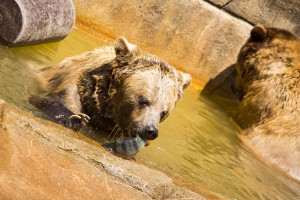
A bear at the Milwaukee County Zoo dines on fish raised by aquaculture researchers at UW-Milwaukee. (UWM Photo by Derek Rickert)
Fred Binkowski raises tens of thousands of yellow perch each year in a lab at UW-Milwaukee’s School of Freshwater Sciences, as he researches ways to improve methods of raising fish, called aquaculture.
Binkowski has been hugely successful in figuring out how to make aquaculture more profitable and sustainable. But the fish he raises also are grown in environments free of disease-causing pathogens.
And that is what caught Mike Hoffmann’s attention.
Hoffmann, zookeeper of the North American areas at the Milwaukee County Zoo, is always looking for ways to stimulate and enrich the lives of carnivores that live in captivity. He wanted to provide fish-eating animals with live prey so that they could hunt for their dinner the way they would in the wild.
Binkowski had exactly what Hoffman was looking for.
The zoo exchanged live food for frozen about 15 years ago because of a fear of parasites and disease that live fish can carry. But Binkowski’s fish are raised in a “bio-secure” environment.
“Central Greens and Growing Power told me I should get in touch with Fred. It turns out, I was calling the right guy because he was a wealth of knowledge and expertise,” Hoffmann said.
At UWM’s recent Alumni Day at the Zoo, the pair hosted a program explaining the partnership, and then Hoffmann fed the fish to the zoo’s grizzly bears, rivers otters and seals.
At the harbor seals’ pool, the large adult male, Ringo, who is blind, was the first to nab a perch, which pleased Hoffmann. “We usually have to give it to him, but he had no trouble this time.”
Seals, Hoffman said, can detect their prey with their sensitive whiskers.
This was not the first time that 1-year-old “King Julian” has eaten live perch. When the pup was being weaned from its mother, Binkowski and Hoffmann used perch to entice the youngster to go to solid food. The plan worked too well – the pup prefers live fish to frozen.
“This is an out-of-the-box collaboration,” said Binkowski, “and it could lead to our lab providing live fish to other zoos, like Chicago’s Brookfield Zoo.”
By Laura L. Otto
